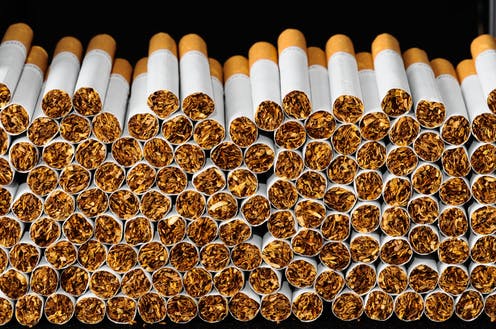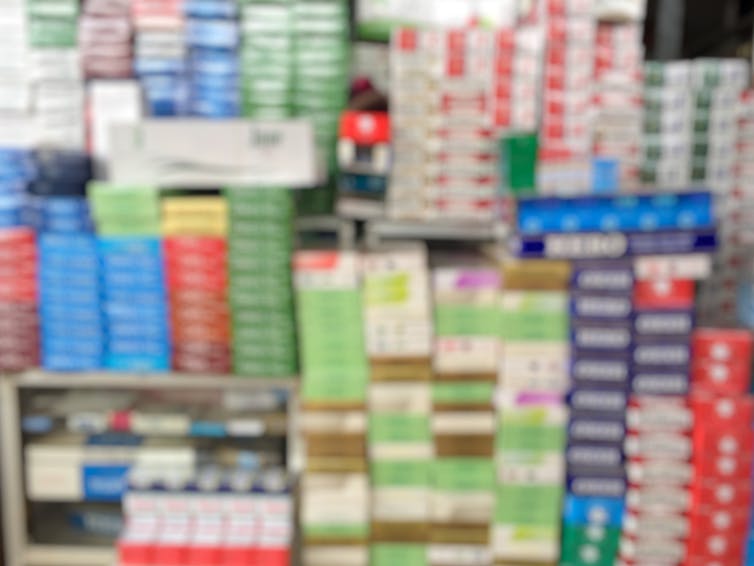What’s the size of the black market in tobacco and who is behind it? These questions have dogged governments, public health advocates, researchers and the tobacco industry for years. The world’s biggest tobacco companies spend millions on research to produce answers – commissioning reports which often conclude that the trade in illicit tobacco is on the rise.
The big tobacco companies routinely use these findings to argue that every tobacco control policy will lead to increases in smuggling – claiming higher taxes encourage more people to buy cigarettes illegally, for example, or that plain packaging makes it easier for counterfeiters to copy big brands.
Yet there are major problems with this industry-funded data. When compared with independent sources, they consistently overestimate the scale of illicit tobacco. They also frequently fail to meet the quality and transparency standards of peer-reviewed research. This raises fresh questions about an industry that has a long history of using research and obfuscation to deceive policymakers and the public – not to mention an intimate involvement with the tobacco smuggling it now claims it helps to prevent.
Our research
Many independent papers and reports have assessed industry-funded data on illicit tobacco. Our research, newly published in Tobacco Control, is the first to systematically review these assessments to examine the wider trend.
We collected 35 assessments, 25 of which focused on research about a single country – most commonly Australia or the UK – while the remainder either focused on a region or a combination of a region and countries. Eighteen assessments were peer reviewed, while all but one of the industry-funded data sources they examined were not.
In 31 of the assessments, the industry-funded estimates of the black market were higher than the reviewer’s estimates – ranging from 17% higher to well over 100%. In 29 assessments, there were criticisms of the methods used to gather the industry-funded data. For example, surveys of used cigarette packs/tobacco pouches were only collected in towns and cities, where illicit products are likely more common.
Spot the difference. khlungcenter
Problems with the data analysis were raised in 22 assessments; while 21 had concerns about presentation, such as failures to highlight when tobacco industry products, rather than counterfeits, comprised the majority of an illicit market. There were also consistent complaints that industry-funded reports failed to clearly convey research methods, making it harder to verify findings.
Our paper concludes that “the quality of industry data on illicit tobacco as a whole is below the expected standard to be considered reliable”. We add that the consistency of this “may indicate that the tobacco industry is deliberately producing misleading data” on this topic.
The bigger picture
In the 1990s, there was overwhelming evidence that Big Tobacco was involved in the illicit tobacco market. According to estimates at the time, one third of global annual cigarette exports could not be accounted for through legal distribution routes.
We have written elsewhere about how this was a core part of companies’ business strategies. Products being sent to markets often greatly exceeded what the local population could consume alone. In some cases, distributors were even tasked specifically with smuggling tobacco company products. The reason tobacco companies would be attracted to the black market is that they get paid when they sell products to a distributor, regardless of how they are sold. As the products sold illegally are cheaper, this potentially translates into higher sales.
By the end of the 2000s, the industry was subject to state investigations, court actions, fines and much negative publicity. The world’s four biggest tobacco companies – Philip Morris International (PMI), British American Tobacco, Imperial Tobacco and Japan Tobacco – had all signed legal agreements with the EU to cooperate in stamping out illicit tobacco. In Canada, subsidiaries of Japan Tobacco and British American, and a company partly owned by PMI had all pled guilty to tobacco smuggling and were collectively fined C$1.7 billion (£1 billion).
Nowadays, the tobacco industry argues it is the victim of the illicit market, emphasising the role of counterfeit cigarettes. Yet there is evidence that the industry has never stopped benefiting from the illicit market – though the major companies deny this. Research we published recently showed that around two-thirds of illicit cigarettes worldwide originate from the tobacco companies themselves, while fewer than one in ten are counterfeits. At this time, there is no sufficiently reliable data about the scale of the black market in tobacco overall.
At best, however, tobacco companies are failing to control their supply chain – overproducing and oversupplying tobacco products, leading to some spilling into the illegal market. Meanwhile, evidence from leaked documents and whistleblowers suggests some tobacco companies were actively involved in the trade as recently as this decade.
Going cheap. Photo Spirit
As part of the global effort to address tobacco smuggling, the World Health Organisation’s Framework Convention on Tobacco Control, the Illicit Trade Protocol, comes into force in September. One key measure of the protocol is a global system to track and trace tobacco products. This system will determine where a product is produced, enabling investigation of it if it ends up on the illicit market.
The protocol specifies that this system must not be controlled by tobacco companies. Nevertheless, tobacco companies have assiduously promoted their own inadequate and inefficient alternative. Codentify was patented by PMI in the mid-2000s, and licensed for free to the company’s main competitors in 2010. They collectively agreed to promote this system to governments in a way that made it seem independent. This was done using various front groups and third parties.
The industry’s involvement in Codentify was nevertheless exposed, so it attempted to distance itself. In 2016 the system was sold to a company called Inexto, and PMI claimed Codentify now complied with WHO requirements. Yet some staff at Inexto appear to be long-time PMI employees credited with creating Codentify, while it also seems that a complex web of shared intellectual property interests exists between these individuals and the two companies. The tobacco industry is still doing all that it can to have this system implemented as the global track and trace standard.
Our new findings about industry data are further evidence that the tobacco industry is not playing a straight bat over illicit tobacco. The data enables these companies to promote conclusions about the scale and nature of the illicit trade which cannot be easily disproved. This primarily appears to serve as a platform for the industry’s lobbying and public relations strategies.
Bloomberg Philanthropies recently announced a US$20m (£16m) investment to create STOP – a global monitoring system to expose practices such as these. Our Tobacco Control Research Group at the University of Bath is one of three partners funded to lead this initiative. We cannot afford to let the industry operate under the cover of darkness. This new partnership will serve as a necessary spotlight.
The Tobacco Manufacturers’ Association, which represents British American Tobacco, Imperial Tobacco and Japan Tobacco subsidiary Gallaher, said it would not be responding to this article.
A spokesman for PMI said:
Illegal cigarette trade hurts our business and revenues – we have a strong interest to reduce it. We invest significant resources to ensure strong controls in our supply chain and tackle the diversion of our products. We also support strict regulation and enforcement measures.
PMI is not in the track and trace business. We believe that the best way of ensuring this is through a range of independently approved, open standard track and trace systems, competing in a free market.



 Brazil’s Supreme Court Orders Jair Bolsonaro to Begin 27-Year Prison Term
Brazil’s Supreme Court Orders Jair Bolsonaro to Begin 27-Year Prison Term  Ethereum Ignites: Fusaka Upgrade Unleashes 9× Scalability as ETH Holds Strong Above $3,100 – Bull Run Reloaded
Ethereum Ignites: Fusaka Upgrade Unleashes 9× Scalability as ETH Holds Strong Above $3,100 – Bull Run Reloaded  U.S. Backs Bayer in Supreme Court Battle Over Roundup Cancer Lawsuits
U.S. Backs Bayer in Supreme Court Battle Over Roundup Cancer Lawsuits  Trump Signs Executive Order to Boost AI Research in Childhood Cancer
Trump Signs Executive Order to Boost AI Research in Childhood Cancer  Trump Hints at Major Autism Announcement, Raises Questions on Tylenol Link
Trump Hints at Major Autism Announcement, Raises Questions on Tylenol Link  EUR/USD Smashes 1.1660 as ADP Jobs Massacre Crushes the Dollar
EUR/USD Smashes 1.1660 as ADP Jobs Massacre Crushes the Dollar  Bitcoin Reserves Hit 5-Year Low as $2.15B Exits Exchanges – Bulls Quietly Loading the Spring Below $100K
Bitcoin Reserves Hit 5-Year Low as $2.15B Exits Exchanges – Bulls Quietly Loading the Spring Below $100K  Amazon Italy Pays €180M in Compensation as Delivery Staff Probe Ends
Amazon Italy Pays €180M in Compensation as Delivery Staff Probe Ends  Novo Nordisk Appoints Greg Miley to Lead Corporate Affairs Amid U.S. Drug Pricing Pressure
Novo Nordisk Appoints Greg Miley to Lead Corporate Affairs Amid U.S. Drug Pricing Pressure  Innovent’s Xinermei Intensifies Weight-Loss Drug Battle in China
Innovent’s Xinermei Intensifies Weight-Loss Drug Battle in China  Peru’s Ex-President Martín Vizcarra Sentenced to 14 Years in Prison for Corruption
Peru’s Ex-President Martín Vizcarra Sentenced to 14 Years in Prison for Corruption  Trump Vows Pardon for Former Honduran President as Honduras Faces Tight Election
Trump Vows Pardon for Former Honduran President as Honduras Faces Tight Election  Merck Nears Acquisition of Cidara Therapeutics at Significant Premium
Merck Nears Acquisition of Cidara Therapeutics at Significant Premium 



































